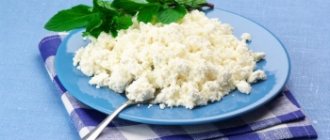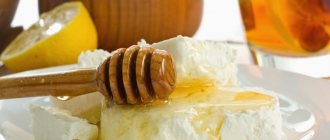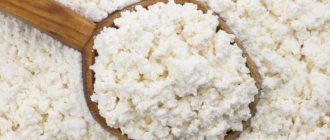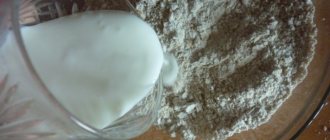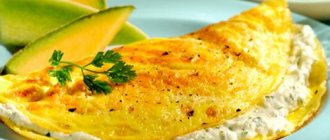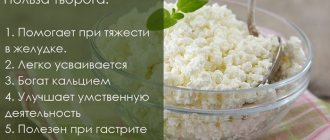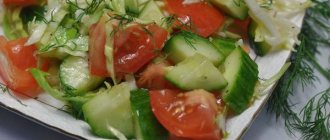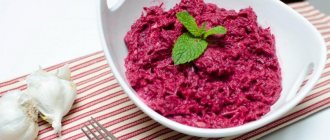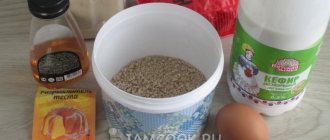Low calorie content of low-fat cottage cheese per 100 grams: losing weight profitably
The low calorie content of low-fat cottage cheese per 100 grams allows this product to be used in any diet.
Interesting: Calorie content of tomatoes with sour cream
Nutritionists say that such dairy products are indispensable for those losing weight, since such cottage cheese contains a fairly large amount of protein (more than 15 g). Let us remind you that in accordance with the current WHO regulations, men are recommended to consume 0.75 g of protein per 1 kg of weight per day; for women this figure is 0.5 g of protein per 1 kg of weight.
Composition and calorie content
In order to get an answer to the question of whether this dish is dietary, you will need to calculate the calorie content of all ingredients. First, we need to find out the energy value of each product per 100 g. Let's start with cottage cheese. It comes in several types, each of which differs in fat content. The most high-calorie cottage cheese is homemade cottage cheese (often called village cottage cheese). It is very nutritious thanks to its fat content of 40%. Translated into calories, its energy value of village cottage cheese varies from 260 to 290 kilocalories. Quite an impressive figure for 100 grams of product.
In turn, the cottage cheese that supermarkets offer us is also divided into several categories:
- regular store-bought cottage cheese – 18% fat content, respectively, 236 kilocalories per 100 grams;
- semi-fat cottage cheese with sugar – 9% fat, or 159 kilocalories;
- light cottage cheese – 5% fat, 121 kilocalories;
- light cottage cheese – 1% fat, 79 kilocalories;
- low-fat cottage cheese, which is essentially dietary - 71 kilocalories.
Let's move on to sour cream. As with cottage cheese, the calorie content of sour cream will vary depending on the fat content of the product. As a rule, the calorie content of sour cream ranges from 100 to 380 kilocalories. One can safely include 10% sour cream as a dietary product - only 115 kilocalories. 15% sour cream contains 158 kilocalories. 20% sour cream contains 206 kilocalories. Those who take care of their figure are advised to avoid using homemade sour cream, because it has 294 kilocalories.
The last ingredient cannot be called dietary or low-calorie, since it is the abuse of granulated sugar that leads to a set of extra pounds
One teaspoon of granulated sugar contains about 30 kilocalories. A tablespoon contains 95 kilocalories, while 100 grams of granulated sugar contains 339 kilocalories - more than 100 grams of homemade sour cream.
Having determined the energy value of each ingredient, you can make calculations. So, for the total volume of the dessert (cottage cheese with the addition of sour cream) we will take one hundred grams. Each of the ingredients is taken in equal proportions, with the exception of granulated sugar - one teaspoon.
Below are two options for counting - dietary and high-calorie:
- dessert made entirely from homemade products and with the addition of granulated sugar - 307 kilocalories;
- low-fat cottage cheese with the addition of 10% sour cream - 122 kilocalories.
Based on the results obtained, we can come to the conclusion that this dessert cannot be classified as a dietary product.
And with a double portion of granulated sugar, you can safely add 30 calories.
For those people who are actively fighting excess weight, consuming curd and sour cream is acceptable, but with some recommendations. First of all, give preference to products that are low-fat or have a minimum percentage of fat. And replace granulated sugar with honey. The calories received from the latter are perfectly absorbed by the body without turning into extra pounds.
Cottage cheese calorie content is 9 percent per 100 grams
The calorie content of cottage cheese is 9 percent per 100 grams, 160 kcal. 100 g of product contains 16.8 g of protein, 9 g of fat, 2.1 g of carbohydrates. 9% cottage cheese is indispensable after viral infections, to increase immunity in the postoperative period.
Interesting: Calorie content of sugar per 100 grams
Contraindications to the use of the product are disorders of the liver, in which it is necessary to minimize the intake of calcium and protein into the body.
Dietary properties of low-fat cottage cheese:
This product contains antibacterial components that inhibit the development of putrefactive bacteria and normalize the microflora of the intestinal tract. Lactose is converted into lactic acid under the action of lactic acid bacteria, which in turn contributes to more efficient absorption of phosphorus and calcium from cottage cheese.
Phosphorus and calcium are minerals that fermented milk products are especially rich in. They give our bones and teeth strength. And these substances are of particular importance in baby food. Milk protein concentrate is the main “raw material base” in the cell building process. Yogurt, kefir and cottage cheese begin to be present in baby food before milk, since they do not provoke allergic reactions and are easily digestible.
Low-fat cottage cheese is a wonderful protein product, containing about 17% protein and a relatively small amount of fat (0.5%). This cottage cheese has a low calorie content - about 80 kcal per 100 g of product, which makes it recommended for obese people. For gout and other diseases associated with metabolic disorders, when meat or fish proteins cannot be consumed, they are replaced with cottage cheese proteins.
Cottage cheese is a product that is widely used in dietary nutrition. The basis of a fairly effective dairy diet is precisely fermented milk products. And even if you limit yourself in nutrition, you can successfully prepare many delicious dishes from cottage cheese. These recipes are known to every housewife.
In fact, this cottage cheese differs from high-fat cottage cheese in its nutritional and energy value. In low-calorie cottage cheese, the fat content is kept to a minimum. This gives it the properties of a dietary product. This means that all or almost all milk fat has been removed from the raw material - milk - by separation. This gives people who are losing weight the opportunity to use this product and not worry about being overweight.
Is low-fat cottage cheese healthy? But have all the healing benefits of cottage cheese been preserved? Low-fat cottage cheese, together with a high-calorie component, is partially or completely deprived of the following substances and properties:
Fat-soluble vitamins A, D, E are practically absent in low-fat cottage cheese. As a result, the bioavailability of calcium decreases. It is less absorbed from a low-calorie product.
Lecithin and cephalin also disappear along with milk fat. The content of proteins and amino acids is slightly reduced. Judge for yourself what low-fat cottage cheese can give to the body?
The benefits of reduced-calorie cottage cheese are controversial among nutritionists. Some say that this product loses most of its amazingly beneficial properties along with fat. Others argue that a light product becomes available to people with obesity and atherosclerosis. Oddly enough, both are right in their own way.
Nutrition experts advise approaching this issue wisely. If you do not have a serious illness (atherosclerosis or kidney failure), then you should not worry about the dilemma: what fat content of cottage cheese is better and healthier to eat? The fight against excess weight must be competent. It’s better to eat classic cottage cheese, enjoy its wonderful creamy taste and enrich your body with unique natural nutrients, and the accumulated calories can very easily be spent by training in the gym or jogging in the park in the fresh air
In addition, the beneficial properties of low-fat cottage cheese are highly valued in cooking, because it is included in numerous low-calorie dishes, which form the basis, for example, for a dietary diet. Low-fat cheesecakes, cheesecakes and dumplings, aromatic casseroles using low-fat cottage cheese are practically no different from dishes prepared using fattier types of this fermented milk product.
By including low-fat cottage cheese in your menu, you will not gain weight, and if you add, for example, a small amount of any fruit, you will get a tasty and healthy dish. So, cottage cheese with banana has an excellent taste, children really like it and is useful for those who want to lose weight. But if you add a spoonful of honey to low-fat cottage cheese, the result will not only be a dietary dish, but also enrich the body with many useful nutrients.
Well, what exactly is the calorie content of this product? And here's what:
Calorie content of homemade cottage cheese per 100 grams
The calorie content of homemade cottage cheese per 100 grams when preparing the product from 1 percent milk is 167 kcal. In 100 g of such cottage cheese there are 17.7 g of protein, 6.5 g of fat, 11.4 g of carbohydrates.
Homemade cottage cheese recipe:
- 3 liters of sour 1 percent milk are mixed with 0.6 liters of kefir, heated over low heat to a temperature of 35 ° C;
- while the milk is heating up, cover a colander with a cloth folded in 6 layers (the edges of the fabric should hang freely from the colander);
- a colander is attached to the container for draining the whey;
- the heated milk is thrown into a colander and a little flows out;
- Without squeezing the resulting mass, tighten the corners of the fabric with a knot;
- the knitted fabric is suspended above the whey container;
- After a few hours, the excess liquid will drain and the cottage cheese will be ready.
Benefits of cottage cheese
The following benefits of cottage cheese are known:
- due to the high content of easily digestible proteins, cottage cheese is useful for people of all ages;
- low-fat cottage cheese is rich in vitamins and minerals and has minimal calorie content, which makes it an essential component of dietary nutrition;
- low-fat cottage cheese is indispensable for children aged 3 years and older; it is necessary to maintain protein balance in the body during breastfeeding and pregnancy;
- cottage cheese minerals strengthen teeth, bones, hair, ensure healthy blood vessels and heart muscle;
- cottage cheese is rich in tryptophan and methionine, which prevent fatty liver and normalize the functions of the gallbladder;
- The minerals in cottage cheese are important for the health of the nervous system.
How to use curd mass?
The main beneficial property will be saturating the body with the necessary amount of calcium. In addition, the low-fat product is not only low in calories, but also covers our needs for milk protein and vitamin B12, which are needed to strengthen cartilage and bone tissue.
This in itself can be called a good prevention of atherosclerosis and osteoporosis. A special amino acid called methionine contained in the product protects us from the appearance of signs of fatty liver.
Low-fat cottage cheese can be served in various forms: with added sugar or salt, warmed or cool. You can add honey, nuts, and fruits to it to increase its calorie content. Some people like to top this product with jam or sour cream, while others add herbs. Even 100 grams of cottage cheese along with a morning cup of tea will give you strength and energy for the coming working day.
The culinary industry readily uses this product: cottage cheese is used to make cheesecakes, cheesecakes, casseroles and dumplings, and even the low calorie content of light cottage cheese does not in any way impair the taste of the finished dishes. Let's see what interesting things can be prepared based on it.
